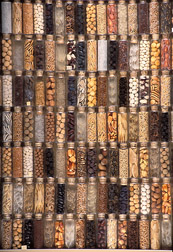Genotyping the DNA of Old, Nonviable Seeds
|
|
Christina Walters has ways of making seeds talk.
Walters is a plant physiologist at the ARS National Center for Genetic Resources Preservation (NCGRP) in Fort Collins, Colorado. Working with plant physiologist Gayle M. Volk and plant geneticist Christopher M. Richards, Walters has demonstrated that it’s possible to persuade seeds to reveal genetic information—even after they’ve lost viability.
“The evidence that usable DNA can be extracted from seeds that can no longer produce plants has significant implications for seed bank management,” Walters says.
Like all genebanks, NCGRP stores genetic materials that researchers can use to study the nature, function, and evolution of genes. Since all seeds lose viability in storage, samples that can no longer germinate are often discarded. But new research shows that even such low-viability seeds can contain research-quality DNA.
Walters and her colleagues examined three sets of seeds—ranging in age from 1 to 135 years—to see if they contained enough intact genetic material to reveal genotypic information about the seeds.
The scientists were able to extract usable DNA from all the seeds—even the last set, which had been stored in a Georgia attic since the Civil War. This is significant because donated collections—such as those Civil War-era seeds—are sometimes infested with microbes that contain enzymes capable of degrading the seeds’ DNA. Fortunately, genetic materials at NCGRP are stored under optimal conditions and are at lower risk for degradation.
Because the oldest seeds in this study are no longer capable of germinating, the scientists have no means of measuring their phenotypes, or observable genetic traits. But stable DNA enables researchers to genotype seeds to uncover information about pedigree or genetic diversity.
“The youngest seeds were in great condition, but even the older seeds had chunks of DNA containing at least 900 base pairs, which will provide enough information to identify a seed’s species and compare it to genetically similar materials,” Walters says.—By Laura McGinnis, Agricultural Research Service Information Staff.
This research is part of Plant Genetic Resources, Genomics, and Genetic Improvement, an ARS national program (#301) described on the World Wide Web at www.nps.ars.usda.gov.
Christina Walters, Gayle Volk, and Christopher Richards are in the USDA-ARS Plant and Animal Germplasm Preservation Research Unit, National Center for Genetic Resources Preservation, 1111 South Mason St., Fort Collins, CO 80521-4500; phone (970) 495-3202 [Walters], (970) 495-3205 [Volk], (970) 495-3201 [Richards], fax (970) 221-1427.
"Genotyping the DNA of Old, Nonviable Seeds" was published in the August 2008 issue of Agricultural Research magazine.







